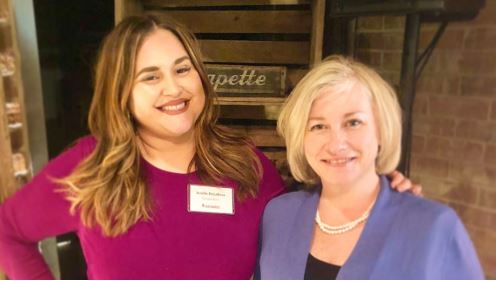4 Things Smart Companies Do To Stay Relevant in Recruiting, According to a Senior Talent Exec

The talent acquisition space is one that’s constantly evolving, and today, those evolutions are occurring at near-breakneck speed, thanks to the influence of technology and social media. With so much motion and innovation happening, though, there’s the risk that speed could be seen as a substitute for true impact.
But Emily Cournoyer, Head of Global Talent Acquisition at Boston Scientific, has managed to harness the best of both. Recently, at a dinner hosted by Fairygodboss, she sat down with Fairygodboss Diversity Advisor Jenelle De La Rosa to talk about the ways organizations can use technology as a means of enhancing the candidate experience — not replacing it. And after four years of heading up the worldwide talent sourcing efforts at Boston Scientific, a leading manufacturer of medical devices, Cournoyer has developed some key takeaways that anyone in the recruiting space would do well to follow.
1. Diversity needs to be a part of your organization’s storytelling and its recruitment strategies.
“Diversity and inclusion is a strategic imperative for us, as well as a value of our organization,” Cournoyer said. “Why I start with that is because you see it mentioned on a lot of websites, and a lot of companies talk about it, but it really is embedded within our culture, from the top down and the bottom up.”
What that looks like, she continued, is things like the company’s CEO signing a pledge in support of diversity and inclusion goals and its CFO running a worldwide diversity council. In short? Diversity is not “just an HR program,” and storytelling efforts about Boston Scientific’s culture don’t make it look like such.
From a talent acquisition standpoint, she said, this means making sure that the company, much like its products, are “representative of the marketplace.”
“We can’t sit and design a product in a room full of the same type of people and design a product that we think will work for a diverse population,” Cournoyer said. “As an organization, the more diversity you have, the more innovation you have. And the more innovation that you have is what’s going to keep you competitive.”
2. Today’s hiring experience can no longer be a passive one — it’s actually quite the opposite.
Cournoyer recalled that in the earlier stages of her career, she would “stand by the fax machine” to receive candidates’ materials. Today, it’s not only the means of receiving applications that’s been transformed — candidates’ expectations around engagement from a potential employer have, as well.
“Now, so much of recruiting is about connecting with people in a really authentic way,” she said. “You have to be really thoughtful about how you’re going after talent, because you do have to go after it — they’re not just coming to us anymore.”
3. To truly engage with candidates, storytelling is essential.
“It’s no longer about advertising the job,” Cournoyer said. “It’s about building the story so that people are interested in learning about you.”
If the demographic you’re interested in hiring is women — and Boston Scientific is, she added, you must tailor your hiring efforts — you have to “go to places where women are looking for jobs, like Fairygodboss.” But you also have to make sure your organization’s story, and not just its jobs, are represented in those spaces.
“It’s so important for us to be talking about our partnerships and what we’ve done in recent years to really improve the workplace for women, whether that’s expanded parental leave, lactation services or workplace flexibility,” she said. “Knowing that an organization has that may be a hook (for a candidate). I think it’s all about how you connect those things as a story so that you become of interest to job seekers in this highly competitive marketplace.”
De La Rosa agreed, adding that it “really boils down to that personal touch.”
“You can have the best jobs and the best culture in the world, but if the right women don’t know about it, are you really doing your due diligence as an organization to connect with those job seekers?” she said.
4. Social media, as a tool for storytelling, is only as effective as it is authentic.
“The baseline for social media really about connecting with people where they are and taking advantage of the opportunity to share authentic stories to make a more direct connection the target audience you’re going after,” Cournoyer said. “You have to own the narrative, and you need to do it in a way that’s authentically representative of you.”
And if your organization isn’t considering social media to be one of its talent acquisition and retention tactics, she added, you have to realize that doesn’t mean the narrative about your company isn’t out there.
“For companies that don’t really make social media a priority, a good friend of mine once said: ‘You can either be part of the conversation or not, but you have to know that conversation is happening without you.’”
For De La Rosa, social media’s storytelling possibilities have been one of the most impactful tactics in Fairygodboss’ approach to cultivating an audience of working women.
“We’ve seen such a huge engagement level and connection for not only us as an organization, but also for our partners through social,” she said. “There’s something to be said for women being storytellers; that’s who we are and how we share information and connect with each other. And I think that’s a great thing that social media allows us to do for brands.”
--
Learn more about careers at Boston Scientific. This article originally appeared on Fairygodboss and is republished with permission.